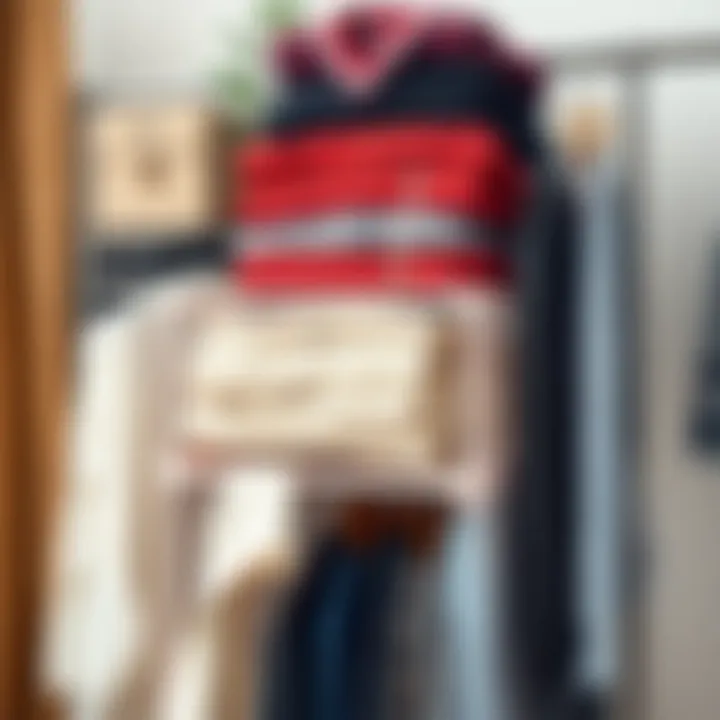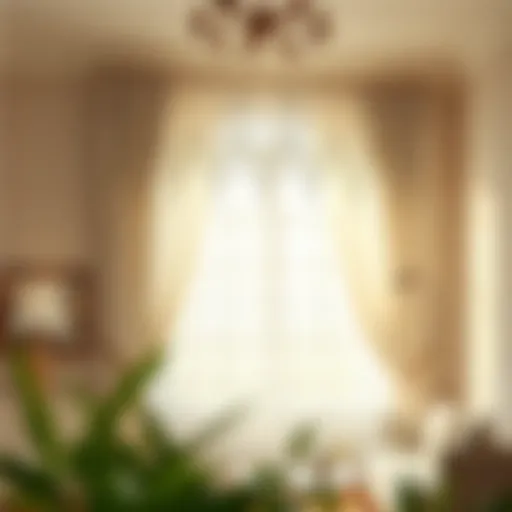Maximize Space with Stacking Clothes Organizers


Intro
Organizing clothes can feel like a daunting task, yet it can also bring an element of peace to our often chaotic lives. When it comes to improving your space, stacking clothes organizers can be a game changer. Not only do they maximize space, but they also allow for better visibility and access to your favorite garments. In this guide, we will explore various aspects of stacking organizers — from their practical uses to aesthetic benefits, and how they can significantly elevate the overall ambiance of your closet.
Understanding the nuances between different styles, materials, and personal preferences is crucial. For instance, modern, minimalistic designs might cater to those with a penchant for sleek interiors, while more eclectic styles might resonate with creative-minded individuals. As we delve into this compendium, expect to uncover practical organization strategies, care tips, and sustainable options that can help you establish a harmonious relationship with your garments.
Ultimately, enhancing your closet serves not merely for utility but also transforms the experience of managing one's wardrobe. Think of it as creating a space that reflects your personality and lifestyle closely.
"A well-organized closet is a reflection of a well-organized mind."
Let’s embark on this journey, armed with knowledge and a flair for style.
Understanding Stacking Clothes Organizers
When it comes to keeping our apparel tidy and accessible, stacking clothes organizers can make a world of difference. These clever tools help us create order in our closets, which for many of us can feel like searching for a needle in a haystack. Now, getting organized isn't just about making things look pretty; it’s about function. By understanding stacking clothes organizers, you can drastically improve your space utilization and streamline your daily routine.
Definition and Purpose
So, what exactly are stacking clothes organizers? Simply put, they are storage solutions designed to maximize vertical space efficiently. Think of them as the Swiss Army knife of storage—versatile, practical, and sometimes even a bit stylish. They come in different shapes and sizes, allowing you to tailor them to fit your specific needs.
The main purpose of these organizers is to offer a practical approach to storing clothing, accessories, or even footwear. When stacked correctly, these units can fit snugly in corners, on shelves, or under your bed—turning unused spaces into functional zones. No more tossing clothes on the floor or rummaging through piles. It’s like bringing a little bit of Marie Kondo magic into your life.
Importance of Organization
The benefits of organization go far beyond mere aesthetics. A well-organized closet can save valuable time each morning. Just picture this: instead of digging through an avalanche of clothing to find that favorite shirt, you can easily spot it in your neatly arranged stack. Clutter can create anxiety—whether you’re someone who thrives in chaos or prefers an orderly setting, a disorganized space can weigh heavy on one’s mind.
Moreover, organized spaces promote better habits. When your clothes are sorted out, it’s easier to maintain a system. You actually start to care for your items more, ensuring they get cleaned and stored properly. Over time, this can even lead to extending the life of your garments.
"An organized closet not only brings peace of mind but can also elevate your overall quality of life."
In our fast-paced world, anything that simplifies our routines deserves a closer look. Stacking clothes organizers not only bring order to our wardrobes but also enhance our overall lifestyle. Through efficient storage and smart categorization, you can turn that chaotic closet into an oasis of calm. Understanding this transformation is key to recognizing why these organizers are a must-have for anyone looking to elevate their space.
Types of Stacking Clothes Organizers
Understanding the various types of stacking clothes organizers is essential for anyone aiming to bring order into their closets or any living spaces. Each type offers unique advantages that cater to different organization styles and needs. By identifying the right option, you can enhance both functionality and aesthetics in your home.
Baskets and Bins
Baskets and bins stand out as popular choices, especially for their versatility and ease of use. They serve not just as storage but as decorative accents in a room. Their soft edges make them safe for households with children, while their placement can be adjusted easily according to your needs.
Material Options
When it comes to material options, these organizers are available in a range of substances, such as natural fibers, plastic, and metal. Natural fibers, like wicker or seagrass, lend a rustic charm that blends well with earthy decors. They breathe well, minimizing the risk of mold while adding texture. However, they can be less durable when exposed to moisture. In contrast, plastic bins provide a lightweight and durable alternative—ideal for storing seasonal clothes or items that may need to be stacked high. The shiny surfaces are simple to wipe clean, albeit sometimes lacking in visual appeal. High-quality metal bins offer a modern aesthetic that works particularly well in contemporary spaces. Their sturdiness is a plus, but they may require careful handling to avoid scratches.
Design Variations
The design variations of baskets and bins are striking. Some may come with lids, while others are wide open, making it easy to grab what you need without sifting through a pile. Lidded baskets help keep dust at bay, making them a handy choice for sensitive clothing or linens. Yet, they can be inconvenient if frequent access is required, as the lids tend to add an extra step. Open designs, on the other hand, encourage a more dynamic environment, promoting quick organization and retrieval. However, this can lead to clutter if not regularly maintained.
Drawers and Shelves
Drawers and shelves offer an organized touch and can manage various items, from clothing to accessories. They can seamlessly fit into existing furniture or stand alone as independent organizers. Their unique structures provide different options depending on available space and preferred styles.
Sliding vs. Fixed
There are two main mechanisms for drawers: sliding and fixed. Sliding drawers are favored for their ease of access. With a simple pull, they allow you to view all contents at a glance, reducing the time spent searching for particular items. Furthermore, they can be configured to fit various depths, which is ideal for tight spaces. However, the sliding mechanism can sometimes wear out, requiring maintenance. Fixed drawers, while providing a solid option for heavy items, lack the flexibility of sliding versions. They can be great for long-term storage but may not be as user-friendly in terms of day-to-day accessibility.
Customizable Solutions
The beauty of customizable solutions lies in their flexibility. You can tailor these organizers to your specific needs by adjusting the dimensions, materials, and configurations. This personalization permits a unique arrangement that suits your living style, maximizing efficiency. However, the trade-off lies in the extra time to set up the system, which can be daunting. Additionally, some customizable options can be more expensive than their standard counterparts. Nevertheless, the investment often pays off in terms of functionality and appearance, melding seamlessly into any decor.
Hanging Organizers
Hanging organizers capitalized on the often-forgotten vertical space within closets or rooms. They enable you to utilize space efficiently while keeping essentials within reach.


Over-the-Door Designs
Over-the-door designs are particularly clever. They make use of existing doors, turning a blank surface into a valuable storage area. This feature is beneficial, especially in apartments or smaller homes where every inch counts. You can find these in various styles, often structured to include pockets of differing sizes. These pockets can organize accessories, shoes, or even clothing. They are excellent for keeping things off the floor and reducing clutter. Yet, this design can become cumbersome if the door swings open frequently, requiring a balance between accessibility and practicality.
Vertical Space Utilization
Vertical space utilization refers to leveraging height in a space rather than occupying the floor area. This is a game-changer in smaller rooms, where wide shelving can't always fit. Adjustable hanging racks and multi-tier systems can be arranged to suit individual preferences, allowing for a tailored approach to garment storage. However, an emphasis on vertical space might lead to less available space for larger items, such as bulky winter jackets. By understanding the dynamics of vertical organization, you can optimize your closet space beautifully.
"Vertical organization isn’t just about height; it’s about creating a harmonious flow in your space."
The variety in stacking clothes organizers provides the tools necessary for effective garment management. Choosing the right types can make a world of difference in achieving a beautifully organized and functional living space.
Choosing the Right Organizer
Selecting the appropriate clothes organizer can significantly alter the way you experience your space. It's not merely about fitting things in a box; it’s about optimizing functionality and reflecting personal taste. A well-chosen stacking organizer maximizes storage while also contributing to the aesthetic appeal of your room. This stage is vital, particularly for fashion designers, stylists, and bloggers who often juggle numerous items while needing quick access to them.
Assessing Space Constraints
Before diving into styles and materials, you first need to assess how much room you've got. Every square foot counts when it comes to clothing storage. Consider dimensions carefully—whether it’s a closet, a corner of a room, or an entire wardrobe. If you have a small space, think vertically; tall organizers can alleviate some issues, letting you use high areas without cluttering horizontal surfaces. More than just measuring empty spaces, be sure also to account for door swings and other furniture pieces that might interfere. This can also dictate the types of organizers that will work.
You might find beneficial advice from sources like Reddit or expert guides on Wikipedia.
"A place for everything and everything in its place; that's the goal, right?"
Personal Style Considerations
Once the measurements are done and space constraints are understood, the next step is to explore how your personal style influences your organizer choice. Consider what materials resonate with you. Are you a fan of natural textures like wood or bamboo, or do you prefer sleek metal and fabric designs? The colors, patterns, and overall aesthetics can tie your storage solutions into the broader design scheme of your living area.
Fitting in with your style means more than just looks—it also involves how easily these organizers fit into your everyday life. If your fashion sense is eclectic, a series of vibrant bins might suit you more than somber colors. Conversely, if minimalism is your jam, opt for streamlined and unobtrusive designs. Your choice should add to, not detract from, the look and feel of your space.
Efficient Organization Strategies
Efficient organization is the backbone of any successful wardrobe management system. In an age where minimalist living and functional spaces are gaining traction, knowing how to effectively organize clothes can not only bring a sense of order to your closet but also save you time and effort in your daily routines. The benefits of implementing efficient organization strategies extend beyond mere aesthetics — they can lead to less clutter, easier access to apparel, and maximized use of available space. Here are key strategies to consider for optimizing your stacking clothes organizers.
Categorization Techniques
By Clothing Type
Sorting clothes by type — such as shirts, pants, dresses, and outerwear — is a straightforward method that serves as a cherry on top of an organized closet. This system makes locating an item a breeze. When your tees are all together, for example, you won't find yourself fishing through half a dozen categories just to grab a simple shirt.
One of the key characteristics of this method is its ease of implementation. It doesn’t require any special tools or tech — just a little thoughtfulness. It’s especially beneficial in a busy household where several people may share a closet, letting each person find their clothes without drama.
However, the approach does have its quirks. Obviously, personal and seasonal pieces may get mixed up unless you adopt a more customized strategy. There’s also the trick of keeping everything tidy so clothes never end up escaping from their designated spot. But overall, when it comes to everyday ease, categorization by clothing type is a steadfast choice.
Seasonal Sorting
Seasonal sorting goes hand in hand with categorization but introduces a tactical layer. Every few months, swapping out winter wear for the lighter summer fabrics can clear up significant space. Homeowners find this constructive, as it allows you to not only simplify access but also maintain garments in appropriate conditions.
The unique feature of this strategy is its responsive nature — it adapts as the seasons change. When winter coats are stashed away after the last snow, the space left behind can be used efficiently by displaying more accessible spring attire. That said, one downside might be the effort required to swap clothes based on seasons; it can feel cumbersome. Still, it resonates particularly well if you live in places where seasons are distinct.
Maximizing Storage Space
Another pillar in the realm of organization strategies is maximizing storage space, ensuring you utilize every nook and cranny. This is especially crucial for smaller living spaces where every inch counts. Finding ways to stretch your available storage can greatly improve how functional your wardrobe becomes.
Using Vertical Space
When it comes to vertical space, the solution often lies in going up—literally. This strategy can take advantage of wall height by installing shelves or racks that store your clothes above. This hierarchy not only keeps clothing accessible but also frees up floor space, giving the illusion of a more open area.
The beauty of this method is in its simplicity. Open shelving or stacked organizers help eliminate clutter, presenting an organized display of items right at eye level. Just remember that height can become a deterrent if items get buried — ensuring everything stays labeled is a key way to keep the system functional.
Incorporating Multi-Functional Furniture
Multi-functional furniture is another clever route to solve the storage dilemma. Think of beds with drawers underneath, ottomans that double as benches, or even fold-out tables. These multifunctional pieces can transform living spaces while providing extra room for clothes that may not have a designated space.


The principal advantage of this strategy is its versatility; with the right piece of furniture, you get storage and function rolled into one. Though perhaps less common, these solutions often serve as conversation starters, marrying utility with style in your living environment. However, the challenge lies in selecting pieces that fit well with your home's design yet still serve the intended purpose.
In summary, the combination of categorizing by clothing type, implementing seasonal sorting, maximizing vertical space, and incorporating multi-functional furniture can create an optimized organization strategy. Such structures are beneficial not just for aesthetics but for overall efficiency in managing a space dedicated to clothing.
By using these tactics, the journey to an orderly closet not only becomes achievable but enjoyable.
Care and Maintenance of Organizers
When it comes to stacking clothes organizers, care and maintenance often take a back seat until problems arise. However, regularly tending to your organizers can extend their lifespan and enhance functionality. A little effort in upkeep can save you money in the long run. Imagine finding your favorite sweater without the hassle of rummaging through a disordered pile—effective maintenance practices can help achieve that.
Material-Specific Care
Cleaning Methods
Cleaning methods vary widely depending on the material of your organizer. For instance, fabric organizers might benefit from a gentle vacuum to remove dust, while plastic bins can often be wiped down with a damp cloth and mild detergent. The shine of a good cleaner can make a significant difference; it not only uplifts the appearance but also prolongs usability. A thorough clean can clear out hidden debris and allergens. Conversely, using harsh chemicals may degrade certain materials. It's crucial to always check manufacturer instructions first; some may even be machine washable, while others may require a simple spot clean.
Here’s a quick rundown on cleaning:
- Fabric Organizers: Vacuum regularly; hand wash when necessary.
- Plastic Bins: Wipe with a cloth; avoid strong solvents that can warp or fade.
- Wooden Drawers: Dust regularly and use a wood cleaner to shine.
The primary advantage of proper cleaning methods is not just in aesthetics but also in the improvement of your garments' condition. Fresh and tidy organizers create a more inviting space.
Long-Term Maintenance Tips
Maintaining your organizers isn't just about cleaning; it encompasses regular checks and smart positioning. Ensuring that your organizers are placed away from direct sunlight can prevent fading and discoloration. Additionally, adjusting shelf heights or repositioning bins according to your needs can enhance organization. Research shows that long-term maintenance routines can lead to better usability over time. For instance, removing items that aren't in season regularly can free up space, while ensuring that everything has a designated spot promotes efficiency. Adjustments like this can be a game-changer in transforming clutter into a harmonious system.
In summary, some solid tips:
- Avoid direct sunlight: Prevents color fading.
- Reassess organization regularly: Keep things functional and accessible.
- Rotate items seasonally: Keep clothing fresh and relevant.
Regular Inspection
Signs of Wear and Tear
Like anything else, stacking organizers encounter wear and tear over time. Knowing what to look for can save you or ruin your storage experience. Cracks in plastic, frayed edges on fabric, or warped wood can signal underlying issues. If you observe any of these signs, it’s time for a closer look. Addressing these issues early can prevent bigger problems later on. For example, a simple repair or replacement can save your clothes from potential damage caused by uneven shelves or poorly maintained drawers. Always consider the durability of the material when assessing its condition.
Looking out for these signs can facilitate better garment preservation and usability:
- Cracks or breaks in plastic or wooden organizers
- Fraying or staining on fabric containers
- Overly loose or stuck drawers
When to Replace Organizers
Knowing when to let go of a worn-out organizer is key. If repairs are spotty or light maintenance isn’t making a noticeable difference, it might be time to replace. New organizers can often offer enhanced functionality and updated designs that a seasoned unit can’t provide. Investing in quality organizers means investing in durability and usability—a wise choice for efficient storage.
Key considerations for replacement:
- Duration of Use: If it’s past the recommended lifespan, it’s probably time.
- Cost of Repairs: If maintenance costs exceed replacement costs, consider a swap.
- Functionality: If it no longer suits your needs, upgrading can be worthwhile.
Sustainable Options in Organization
In recent years, the conversation around sustainability has moved from the background to the forefront, particularly concerning consumer choices in home organization. When selecting stacking clothes organizers, considering sustainable options is not just a trend; it reflects a commitment to the environment that resonates with an increasingly conscious audience. Sustainable options often translate into quality products that, although they might start as higher investments, can end up saving money in the long run through durability and efficacy. The benefits of utilizing eco-friendly materials include reduced carbon footprints, support for responsible manufacturing, and enhanced aesthetic appeal, which resonates with a variety of personal styles.
Eco-Friendly Materials
One of the cornerstones of sustainable organization lies in the materials chosen for these products. Two particularly noteworthy options are bamboo and recycled plastics.
Bamboo
Bamboo stands out as a champion of eco-friendly materials. Known for its rapid growth, this grass can be harvested in a way that doesn’t harm the ecosystem, making it a renewable resource. The natural properties of bamboo contribute to its popularity: it's lightweight, yet incredibly strong, which means organizers can be both functional and stylish. Its unique texture adds a warm, earthy feel to any space, enhancing the overall aesthetic.
Moreover, bamboo's inherent antibacterial properties make it a beneficial choice for clothing storage, as it helps reduce odors and moisture buildup. However, there can be disadvantages; it requires specific care to maintain its quality in humid conditions, and not all bamboo products are created equal. It's vital to source from reputable brands that practice sustainable harvesting to truly gain the environmental benefits.
Recycled Plastics


Recycled plastics present another sustainable material option that deserves attention. Utilizing plastics previously discarded, manufacturers breathe new life into materials that could otherwise sit in landfills for centuries. This process not only reduces waste but also conserves energy compared to producing new plastics. The key characteristic of recycled plastics is their versatility; they can be molded into various designs and sizes, making them suitable for diverse organizational needs.
Something unique about recycled plastics is their resilience; they are generally resistant to moisture and wear, which is paramount in environments like closets that may experience varying temperatures and humidity levels. However, they come with their own set of challenges. While they are a step toward sustainability, not all recycled plastic products are biodegradable or free from harmful chemicals, so careful consideration of product sourcing is essential.
Ethical Brands to Consider
Aligning with a brand that mirrors your values can enhance your commitment to sustainability. Several brands focus on ethical practices and eco-friendly materials, like The Container Store, which not only provides high-quality organizers but also promotes sustainability through its product lines. Other brands like mDesign focus on creating functional and aesthetically pleasing products sourced responsibly. When exploring options, consider researching the brands you are interested in through sources like Wikipedia or brand reviews on Reddit.
By investing in sustainable options, you're not just organizing your space but also supporting a healthier planet for future generations.
Trends in Clothing Organization
Understanding the latest trends in clothing organization is essential for anyone looking to elevate their space, be it a professional environment or a personal abode. With the ever-changing landscape of lifestyle needs and preferences, these trends highlight both the practical and aesthetic advantages that modern solutions can bring to garment management. By staying current with organization trends, individuals can create spaces that are not only functional but also stylish, ensuring that their clothing arrangements are conducive to both ease of access and visual appeal.
Minimalism and Decluttering
In today’s fast-paced world, minimalism has emerged as more than just a passing fancy; it’s a lifestyle choice. People are increasingly embracing fewer possessions to simplify their lives and create a serene atmosphere. This trend extends beyond mere aesthetics; it resonates deeply with the psychological benefits of living clutter-free.
By adopting a minimalist approach to clothing organization, individuals can focus on retaining only those items that serve their needs and reflect their personal style. This concept of decluttering isn't just about tossing things out; it's an active process of reevaluating one's wardrobe. For instance, tackling the seasonal wardrobe swap is now a thoughtful exercise rather than a chore. More folks are considering falling into the habit of only keeping what genuinely brings them joy or utility.
- Key Strategies for Minimalism in Clothing Organization:
- Evaluate each item: Keep garments that you wear regularly or have a meaningful connection to your life.
- Create a capsule wardrobe: Select versatile pieces that mix and match easily, focusing on quality over quantity.
- Regularly review: Make it a habit to reassess your wardrobe, ensuring it aligns with your current lifestyle.
Adopting these practices not only simplifies one’s space but also transforms the perception of personal belongings, paving the way for a more intentional lifestyle.
Smart Storage Technology
As technology advances, the realm of clothing organization is becoming smarter and more integrated into our daily lives. Innovations in smart storage solutions are gaining traction, making it easier to keep garments organized while adding a layer of convenience. The trend toward smart solutions responds to the need for efficient space usage in increasingly compact living environments.
Smart Garment Boxes
Smart garment boxes are at the forefront of this trend. These devices often include features such as climate control and UV protection, which help preserve delicate fabrics while keeping them organized in an aesthetically pleasing manner. One striking characteristic of smart garment boxes is their ability to communicate with mobile apps, allowing users to manage their clothing digitally. Users can categorize items, find garments quickly, and even receive notifications when it’s time to clean or rotate their wardrobe.
- Advantages of Using Smart Garment Boxes:
- Preservation of fabrics: Protects clothing from dust and damage.
- Accessibility: Quickly locate any piece without rifling through piles.
- Organized updates: Logs item usage to help maintain a balanced wardrobe.
While these boxes can be more expensive than traditional storage options, their efficiency and protective qualities often justify the added cost for many users concerned with maintaining their clothing collection.
Automated Solutions
Automated solutions are taking storage to the next level, employing technology to streamline the organization process. These systems can include automatic drawers or smart shelving that adjust to accommodate different garment types seamlessly. This allows for a dynamic organization that adapts to one’s lifestyle or wardrobe changes.
A key element of automated solutions is their user-friendly interfaces, often designed to integrate with smart home technology. This aspect not only enhances user experience but also makes clothing management much simpler.
- Advantages of Automated Solutions:
- Customizable settings: Easily change configurations to suit garments of any size or style.
- Space efficiency: Maximize storage without sacrificing room aesthetics.
- Seamless daily use: Quick access to clothing encourages more strategic outfit planning.
Despite the higher initial investment, automated systems are increasingly viewed as enriching family or personal life, enhancing the overall experience of clothing organization.
End
As we tie the bow on this extensive guide, the importance of stacking clothes organizers becomes crystal clear. They are not just mere tools for storage; they embody a lifestyle choice that emphasizes efficiency, aesthetics, and sustainability. Investing in suitable organizers can profoundly enhance the functionality of your spaces. Moreover, by utilizing these containers, one can markedly reduce clutter and foster a sense of tranquility within the home environment.
Summary of Key Points
- Versatile Storage Options: From baskets to drawers, the types of stacking organizers available cater to various needs and spaces. Different materials also allow for personalization while meeting practical requirements.
- Sorting and Categorization: Understanding how to categorize clothing efficiently can significantly transform the organization process. Knowing which items go where saves time, especially on busy mornings.
- Maintenance and Care: Regular upkeep of your organizers ensures they remain in good condition longer, thus minimizing the need for replacement.
- Sustainable Choices: With a growing awareness of environmental issues, opting for eco-friendly materials in your organizers is both responsible and stylish.
Final Thoughts on Stacking Organizers
When it comes to clothing organization, stacking clothes organizers pave the way for both improved access and aesthetic appeal. They transform chaotic closets into serene spaces, where everything has a place and is easily visible. Imagine stepping into your closet and feeling overwhelmed by choices that are simply organized.
Moreover, having a plan for organization encourages individuals to reassess their clothing habits. It’s about more than just storage; it’s about mindful consumption and fostering a wardrobe that truly reflects personal style.
Ultimately, as we have explored here, stacking clothes organizers offer significant benefits beyond simple storage solutions. They enhance the entire garment management experience and encourage a balanced approach to fashion and sustainability. By making informed choices about the types of organizers you choose and how you use them, you can create a well-organized space that inspires creativity and functionality in your everyday life.
For additional insights, consider resources such as Wikipedia or Britannica for further reading.















